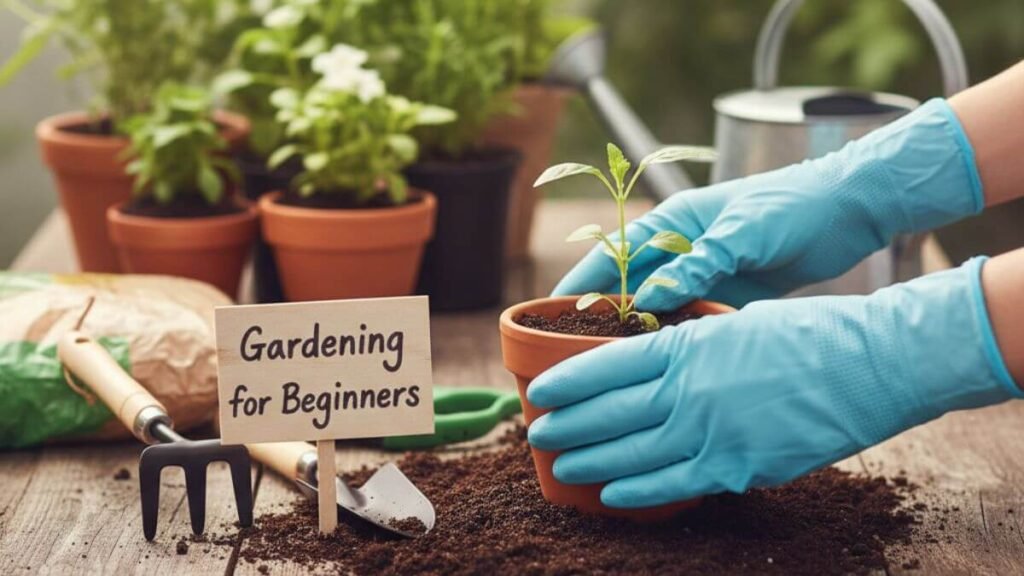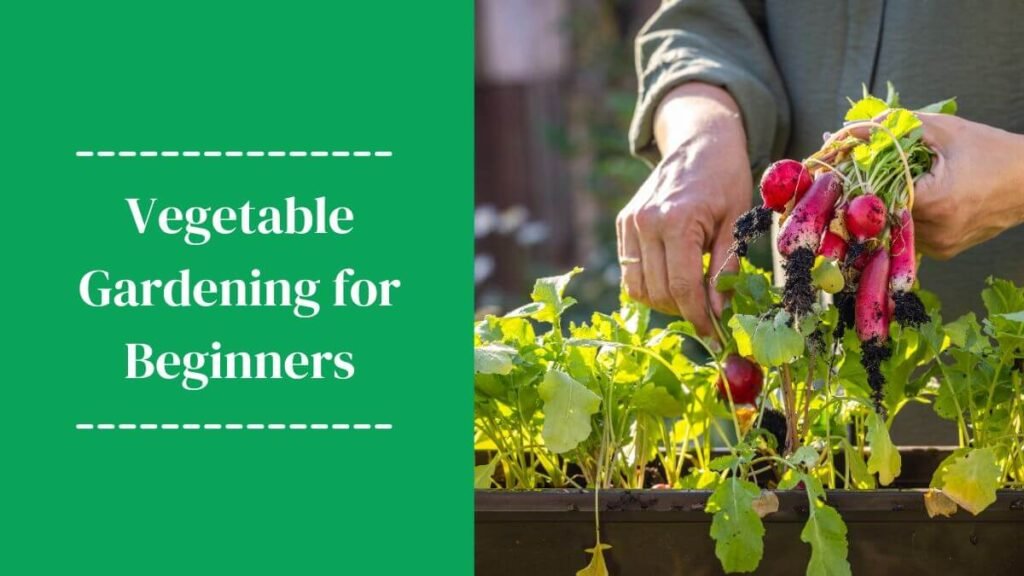
Imagine walking out your door and gathering fresh, crisp lettuce or that just-right ripe tomato from the garden. Growing your own vegetables is more than a hobby; it’s a gratifying lifestyle choice that encourages better health, saves money, and provides support for the idea of a more sustainable way of living.
This is due to the fresh, chemical-free vegetables one would have constantly in store. Besides the great taste, it is an easy way of saving money spent for groceries, wasting less food, and reducing your ecological footprint.
In this beginner’s guide on vegetable gardening for beginners, learn all you need to know for growing your first vegetable garden-from choosing the right location, preparing the soil, planting, care, and harvest of crops. Regardless of having a big back yard or a small balcony, these practical tips would surely help you grow healthy and thriving vegetables with a lot of confidence.
Remember, the idea is to start small and have fun. Garden doesn’t need to be complicated. With the right set of approach, you will soon experience the joy and satisfaction that comes from eating food you have grown yourself.
1. Benefits of Growing Your Own Vegetables
Starting a vegetable garden at home comes with countless rewards that go far beyond just having fresh food on your table. From improving your health to saving money and living more sustainably, here’s why growing your own vegetables is worth every bit of effort:
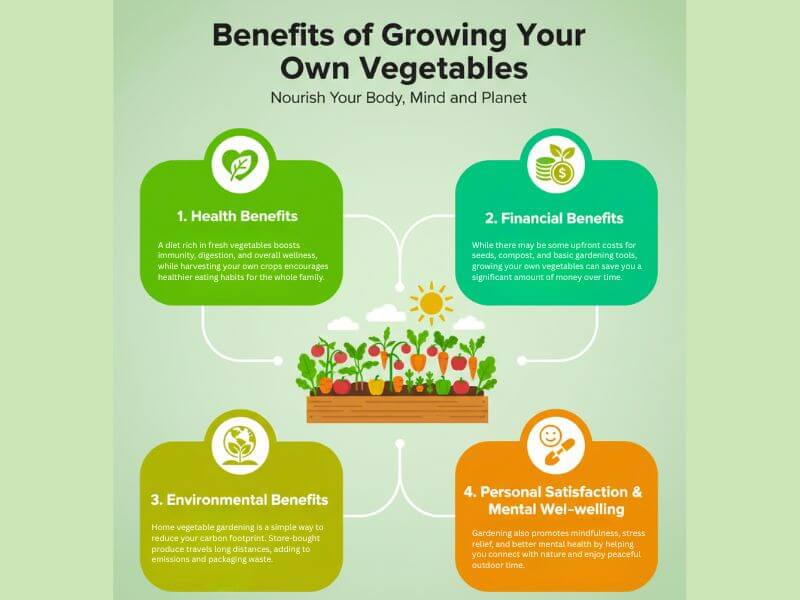
# Health Benefits
Homegrown vegetables are fresher, more nutritious, and chemical-free. By growing your own food, you control the soil and avoid harmful pesticides or preservatives. A diet rich in fresh vegetables boosts immunity, digestion, and overall wellness, while harvesting your own crops encourages healthier eating habits for the whole family.
# Financial Benefits
While there may be some upfront costs for seeds, compost, and basic gardening tools, growing your own vegetables can save you a significant amount of money over time. A small packet of seeds can yield pounds of produce—far more affordable than buying organic vegetables at the grocery store.
With a well-maintained garden, your monthly grocery bills can drop, especially during peak harvest seasons.
# Environmental Benefits
Home vegetable gardening is a simple way to reduce your carbon footprint. Store-bought produce travels long distances, adding to emissions and packaging waste. By growing food locally, you cut transportation, use less plastic, and create a more sustainable, eco-friendly garden—especially when you compost kitchen scraps and use natural methods.
# Personal Satisfaction and Mental Well-being
Vegetable gardening offers a deep sense of personal satisfaction. Watching seeds grow into healthy plants and harvesting your own produce is incredibly rewarding. Gardening also promotes mindfulness, stress relief, and better mental health by helping you connect with nature and enjoy peaceful outdoor time.
You can read the article: “Gardening for Beginners: How to Avoid Common Mistakes”
2. Planning Your Vegetable Garden
Before planting your first seed, planning your vegetable garden is one of the most important steps to set yourself up for success. A well-thought-out garden layout saves you time, effort, and frustration while ensuring your plants have the ideal conditions to thrive. Whether you have a spacious backyard, a small balcony, or just a few containers, careful planning will help you grow healthy, productive vegetables throughout the season—perfect for anyone interested in vegetable gardening for beginners.
# Choosing the Right Location
The location of your garden plays a major role in how well your vegetables grow. Most vegetables need at least 6–8 hours of direct sunlight each day to thrive. Sunlight is crucial for photosynthesis, helping your plants grow strong and produce abundant harvests.

In addition to sunlight, make sure the area you choose has good drainage to prevent waterlogging and is sheltered from strong winds, which can damage tender plants.
# Deciding What to Grow
Choosing the right crops is key, especially if you’re just starting out. Begin with easy-to-grow vegetables that don’t require complicated care. Some beginner-friendly options include:
- Lettuce and leafy greens
- Tomatoes
- Carrots
- Bell peppers
- Radishes
For the best results, focus on seasonal vegetables that grow well in your local climate. Check a regional planting calendar to find out which crops perform best in each season and align your planting schedule accordingly.
# Choosing the Right Garden Size
If you’re new to vegetable gardening, it’s best to start small. Even a 2×2-foot container garden can yield an impressive amount of fresh produce when planned correctly.
# Planning for Succession Planting
To keep your garden producing all season long, consider succession planting. This method involves planting new crops at regular intervals to ensure a continuous harvest rather than one large yield all at once.
3. Understanding Soil and Fertilizers
Healthy, nutrient-rich soil is the foundation of a thriving vegetable garden. Even with proper watering and sunlight, plants won’t grow well if the soil isn’t fertile. By understanding your soil type and using the right fertilizers, you can create the perfect environment for strong, productive plants, which is especially important for anyone interested in vegetable gardening for beginners.
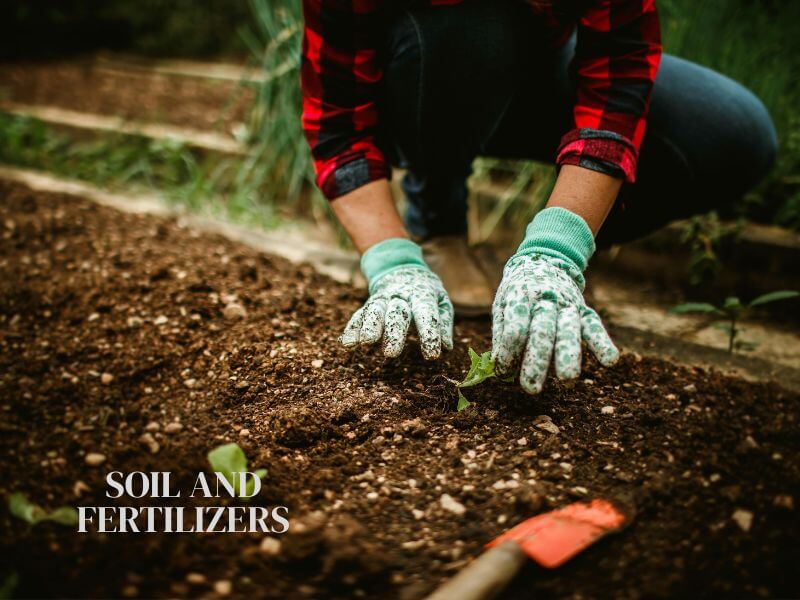
# Basics of Good Garden Soil
Healthy soil is the foundation of a thriving vegetable garden. Aim for loamy soil, which balances sand, silt, and clay—offering great drainage, moisture retention, and aeration for strong roots.
To improve your garden soil:
- Ensure good drainage to prevent waterlogging and root rot.
- Add organic matter like compost or aged manure to boost fertility and texture.
- Amend soil regularly to keep it rich, healthy, and productive year after year.
# Testing Soil pH and Nutrients
Most vegetables grow best in slightly acidic to neutral soil with a pH between 6.0 and 7.0. If the pH level is off, plants may struggle to absorb nutrients—even if the soil is rich.
You can easily use a home soil test kit to measure pH and nutrient levels.
- If your soil is too acidic, add lime to raise the pH.
- If it’s too alkaline, add sulfur to lower the pH gradually.
Regular soil testing ensures your plants get the nutrients they need and helps you make informed decisions about fertilizers and amendments.
# Organic vs. Synthetic Fertilizers
Fertilizers replenish the nutrients that plants use as they grow. There are two main types to consider:
Organic Fertilizers:
Compost, worm castings, bone meal, and fish emulsion release nutrients slowly, improve soil structure, and support beneficial microbes, making them perfect for sustainable vegetable gardening.
Synthetic Fertilizers:
These give a quick nutrient boost for fast-growing crops but can harm soil health over time. Use them sparingly and combine with organic matter for balanced growth.
For most home gardens, organic fertilizers are the best choice for building long-term soil health.
# Composting and Soil Enrichment
Composting is an easy, eco-friendly way to enrich your garden soil. Recycle kitchen scraps like fruit peels, veggie trimmings, coffee grounds, and garden waste to create nutrient-rich compost that naturally boosts soil fertility.
Mixing compost into your garden soil helps to:
- Enhance water retention while preventing compaction.
- Encourage beneficial microorganisms that improve soil structure.
- Support healthier, stronger plant growth throughout the growing season.
Starting a simple compost pile or using a compost bin is inexpensive and highly effective for maintaining healthy garden soil year after year.
4. Selecting Seeds and Seedlings
Choosing the right seeds and seedlings is one of the most important steps in setting your vegetable garden up for success. The quality of your seeds and how you start them directly impacts how healthy and productive your plants will be. By understanding your options and selecting carefully, you can give your garden the best possible start.
# Direct Sowing vs. Starting Indoors
When it comes to planting vegetables, you have two main methods: direct sowing or starting seeds indoors. Each has its benefits depending on the type of crop and your local growing conditions.
- Direct Sowing:
Plant seeds directly in the garden. Best for fast-growing, cold-tolerant crops like carrots, radishes, and leafy greens. Simple and low-maintenance—perfect for beginners.
- Starting Indoors:
Start seeds in trays or pots before transplanting outside. Ideal for tomatoes, peppers, and eggplants. This method gives seedlings a head start by controlling light, temperature, and moisture.
# Choosing Healthy Seeds and Seedlings
The quality of your seeds and seedlings plays a major role in your garden’s success. Here’s what to look for:
- Certified organic or high-quality seeds: These ensure strong, healthy plants that are free from chemical treatments.
- Seedlings with vibrant, green leaves and strong roots: Healthy seedlings should look sturdy and well-developed.
- Avoid plants that look weak, yellow, or wilted, as these may be stressed, diseased, or less likely to thrive after transplanting.
Investing in quality seeds may cost a little more upfront, but it pays off with healthier growth and higher yields.
# Storing Seeds Properly
If you have leftover seeds after planting, proper storage is essential to keep them viable for future seasons.
- Store seeds in a cool, dry place, away from direct sunlight and humidity.
- Use airtight containers such as jars or resealable bags to keep out moisture.
- Label each container with the seed type and date to stay organized.
When stored correctly, many seeds remain viable for several years, allowing you to save money and plan ahead for future planting seasons.
For more relevant hobbies you can see the article “11 Fun Outdoor Hobbies for Couples“
5. Planting and Care Basics
After preparing your soil and selecting seeds, proper planting and consistent care are essential for a thriving garden. Focusing on spacing, watering, mulching, and plant support ensures healthy growth and bountiful harvests, making these practices especially helpful for vegetable gardening for beginners.
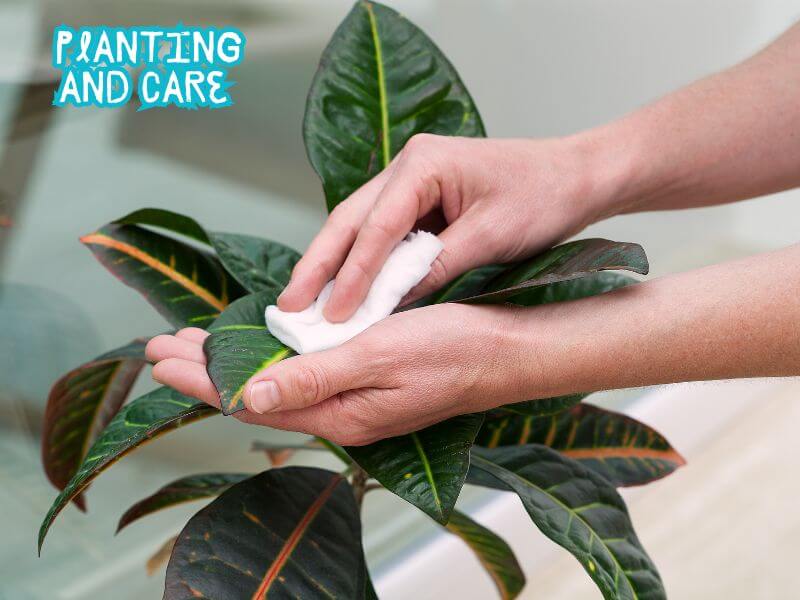
# Spacing, Depth, and Timing
Follow seed packet instructions for spacing and depth. Crowded plants compete for nutrients, while planting too deep can stunt growth. Timing is also essential—plant when soil and air temperatures suit the specific vegetable.
# Watering Guidelines
- Most vegetables require 1–2 inches of water per week.
- Water early in the morning to reduce evaporation.
- Avoid overhead watering; drip irrigation or soaker hoses keep leaves dry, reducing disease risk.
# Mulching for Moisture and Weed Control
Mulching with straw, leaves, or wood chips helps:
- Retain soil moisture
- Suppress weeds
- Maintain even soil temperature
# Supporting Plants
Some plants, like tomatoes, peas, and beans, need support:
- Stakes: Keep tall plants upright.
- Trellises: Ideal for climbing plants like cucumbers.
- Cages: Prevent sprawling tomatoes from touching the soil.
6. Pest and Disease Management
While pests and plant diseases are common challenges in vegetable gardening, proactive care and smart strategies can help you manage them effectively. By understanding how to identify issues early and taking preventive measures, you can protect your garden and maintain healthy, productive plants.
# Common Pests
Several pests can damage vegetables, especially in the early stages of growth. Keep an eye out for:
- Aphids, caterpillars, slugs, and snails.
- Identification: Look for holes in leaves, sticky residue, or visible insects.
# Natural Pest Control
You don’t need harsh chemicals to keep pests at bay. Some effective, eco-friendly methods include:
- Introduce beneficial insects like ladybugs.
- Use neem oil or insecticidal soap.
- Companion planting: For example, planting marigolds near tomatoes repels nematodes.
# Recognizing Plant Diseases
Diseases can spread quickly if not managed. Common issues include:
- Fungal diseases like powdery mildew or blight can spread quickly.
- Remove affected leaves promptly and improve airflow between plants.
# Preventive Measures
Preventing pests and diseases is always better than treating them after they appear. Key preventive practices include:
- Rotate crops each season to reduce soil-borne diseases.
- Avoid overwatering, which promotes fungal growth.
7. Harvesting Your Vegetables
Knowing when and how to harvest your vegetables is essential for enjoying the best flavor, texture, and nutritional value. Harvesting at the right time not only improves taste but also encourages plants to continue producing throughout the season.
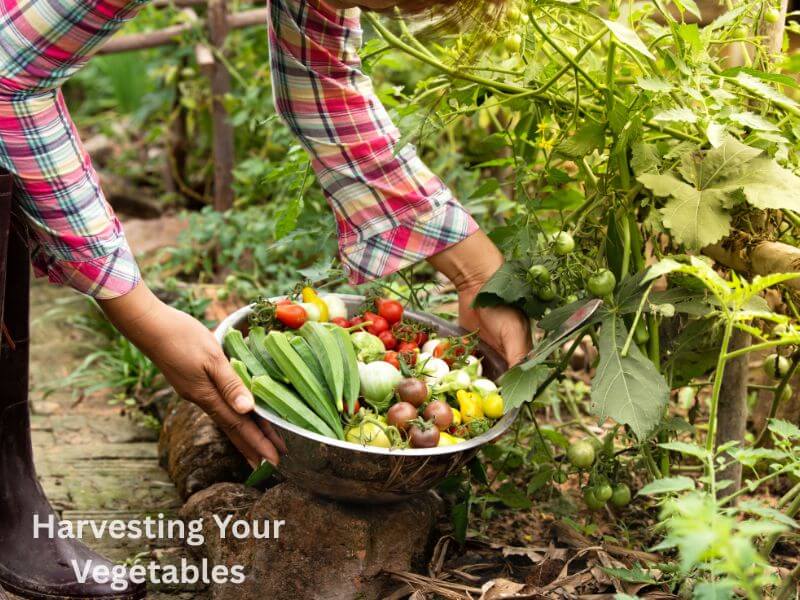
# Signs of Readiness
Different vegetables have specific indicators that signal they’re ready to harvest:
- Tomatoes: Firm but slightly soft, fully colored.
- Lettuce: Leaves large enough to eat, before bolting.
- Carrots: Size indicated on seed packet.
# Prolonging the Harvest Season
To enjoy a continuous supply of fresh vegetables:
- Harvest regularly to encourage continuous growth.
- Use succession planting for ongoing supply.
# Proper Harvest Techniques
Using the correct harvesting methods protects both your plants and the produce:
- Cut, don’t pull, vegetables to avoid damaging the plant.
- Use clean, sharp tools for cutting fruits and leafy greens.
# Storing and Preserving Produce
Proper storage extends the shelf life of your harvest and prevents spoilage:
- Leafy greens: Store in a cool, humid environment.
- Root vegetables: Keep in a dark, cool place.
- Consider freezing, pickling, or drying surplus vegetables.
With proper storage and preservation, you can enjoy the fruits of your labor long after harvest season ends.
For more relevant hobbies you can see the article “12 Attractive Hobbies for Seniors”
8. Tips for Success and Common Mistakes to Avoid
Starting a vegetable garden can be highly rewarding, but beginners often face challenges. By following these tips and avoiding common mistakes, you can set your garden up for success and enjoy bountiful harvests, making them especially valuable for vegetable gardening for beginners.
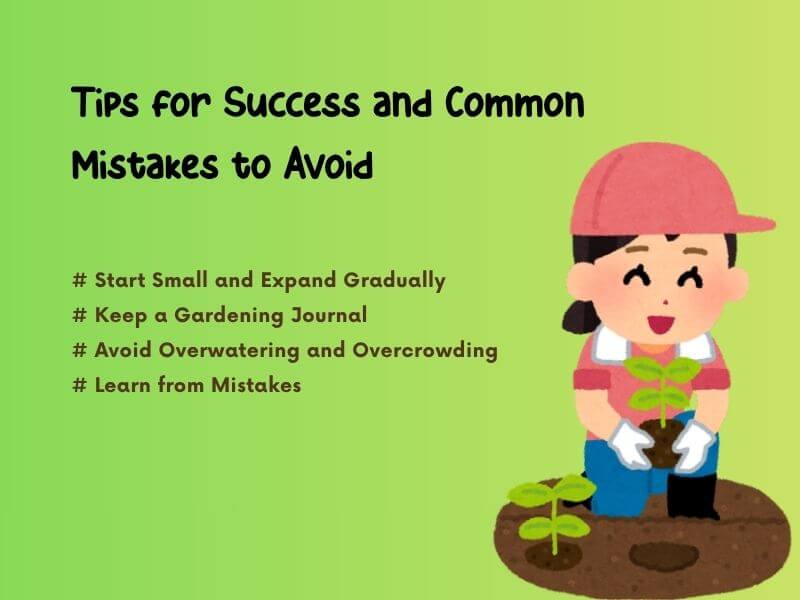
# Start Small and Expand Gradually
Begin with a few easy-to-grow crops like lettuce, tomatoes, or radishes. Starting small helps you learn watering, soil care, and pest managementwithout feeling overwhelmed. As you gain confidence, gradually expand your garden with more crops and larger spaces.
# Keep a Gardening Journal
A gardening journal helps you track progress and improve each season. Record planting dates, growth, harvests, and challenges like pests or diseases. Reviewing your notes helps optimize planting schedules and avoid repeating mistakes.
# Avoid Overwatering and Overcrowding
Common beginner mistakes are overwatering and overcrowding. Water deeply but less often to prevent root rot, and follow spacing guidelines to reduce competition for nutrients, sunlight, and water. Proper watering and spacing ensure healthy, productive plants
# Learn from Mistakes
Gardening is a learning process, and even experienced gardeners make mistakes. Don’t get discouraged if some plants fail or pests affect your crops. Every challenge is an opportunity to learn and improve for future seasons. Over time, you’ll develop the skills, intuition, and confidence to maintain a thriving vegetable garden.
FAQs for Beginner Vegetable Gardeners
Q1: How much sunlight do vegetables need?
Most vegetables need 6–8 hours of direct sunlight daily. Leafy greens like spinach can tolerate partial shade.
Q2: How often should I water my garden?
Generally, 1–2 inches of water per week is sufficient. Adjust based on weather, soil type, and plant needs.
Q3: What vegetables are easiest for beginners?
Lettuce, radishes, carrots, tomatoes, and bell peppers are great beginner-friendly options.
Q4: Can I grow vegetables in containers?
Yes! Many vegetables like tomatoes, peppers, and herbs thrive in pots. Ensure containers have proper drainage.
Q5: How do I prevent pests naturally?
Introduce beneficial insects, use neem oil, practice crop rotation, and plant pest-repellent companions like marigolds.
Starting your vegetable garden as a beginner doesn’t have to be intimidating. By planning carefully, selecting the right plants, caring for your soil, and understanding basic plant needs, you can grow your own food successfully. The rewards are plentiful: fresh, nutritious produce, cost savings, environmental benefits, and personal satisfaction.
Even if you start with a small container garden or a single raised bed, the key is to start today. Plant one vegetable this week, nurture it, and experience the joy of harvesting your own homegrown food. Gardening is more than growing vegetables—it’s cultivating a connection with nature, yourself, and the food you eat.
YOU CAN ALSO READ :
*Best 14 Hobbies to Do at Home to Stay Active and Mentally Refreshed.
*Top Secrets of Autograph Collecting: The Essential Handbook for Aspiring Collectors.
*Gardening for Beginners: How to Avoid Common Mistakes
